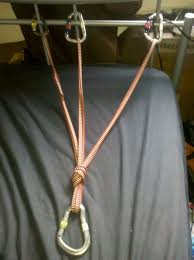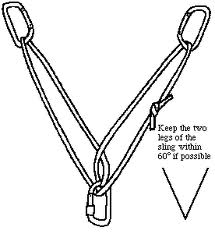Discuss and demonstrate effects of friction and vector pulls on anchors
Some tricks of the trade are setting anchors as close to the ground as possible. Use padding and avoid friction wherever possible. Favor decent sized pulleys over carabineers for change of direction or as the traveling pulley. A good rule of thumb is the pulley needs to avoid bending the rope in a loop less than a 4:1 turning radius. A 2" pulley is perfect for a 3/8" hauling line. Adding an extra pulley to avoid running the rope over a shelf edge of rock is always a wise precaution. Anchors fail sometimes, often due to shifting loads. Try to predict where projectiles will fly and take precautions. Always wear your safety gear.
When setting a two anchor point system, remember how a vector pull works. That real skinny person can easily topple two really big persons when the line is taught (180o) by pulling in the middle of the rope. Reduce the angle to 45o and you have an even match. Try to make the angle of pull on the anchors 90o or less.
Beware of rubbing any of your soft lines over a hard surface like a rock. The rock will act like sandpaper and eventually wear out the line (or worse yet - cut it). When confronted with this challenge, try padding with some clothing or better yet, add an extra pulley to avoid this contact. A more subtle example is a carabineer with somewhat sharp edges. A major advantage of a pulley over a carabineer is greatly reduced friction. Friction not only causes wear, it can add a great deal of heat and this can be a real concern with Polypropylene line which has a low melting point.
Here is a nice video on padding anchors and how to select good anchor points: Padding Anchors.
Understand the rationale for self-equalizing, load distributing anchors in swiftwater rescue
 Swiftwater Rescue is a very dynamic environment. A great example is unpinning a boat, once the boat is freed it will travel downstream very quickly and with a great deal of force. This is why we typically add a second independent tag line. Now lets consider the effect on a multipoint anchor. Life is great when you can pull in a straight line and the load is shared equally amongst the anchor points. What happens to a load sharing system when the object moves? One of the anchors will need to take pretty much all of the load. Since we typically choose a multipoint system due to lack of a decent bomb proof anchor, our system is likely to fail.
Swiftwater Rescue is a very dynamic environment. A great example is unpinning a boat, once the boat is freed it will travel downstream very quickly and with a great deal of force. This is why we typically add a second independent tag line. Now lets consider the effect on a multipoint anchor. Life is great when you can pull in a straight line and the load is shared equally amongst the anchor points. What happens to a load sharing system when the object moves? One of the anchors will need to take pretty much all of the load. Since we typically choose a multipoint system due to lack of a decent bomb proof anchor, our system is likely to fail.
 A self equalizing anchor system is more flexible. As the towed object moves, the angles change to ensure all anchor points share the load. Eventually, even this system will fail when the angle is two wide as in a vector pull. This is where the extra tag line comes into play.
A self equalizing anchor system is more flexible. As the towed object moves, the angles change to ensure all anchor points share the load. Eventually, even this system will fail when the angle is two wide as in a vector pull. This is where the extra tag line comes into play.
Demonstrate one and two point anchors using natural and man made features
All instructors will need to demonstrate they can tie both one point and two point anchor systems. If you need a refresher, check out the following articles:
Discuss desirable features of one and two point anchors
When setting anchors, we are looking for something really stable to anchor to. Some great examples are live trees over 6" in diameter, boulders that weigh several tons, solid manmade features, etc. This type of a bomb proof anchor is essential for One point anchors systems.
What can you do if all you have are marginal anchors? This is where multipoint systems need to be used, preferably with some type of backup tagline. A key safety practice when using multipoint systems is small deep angles to avoid a vector pull. Here is a short article on Two point anchor systems.
Page 1 of 3
